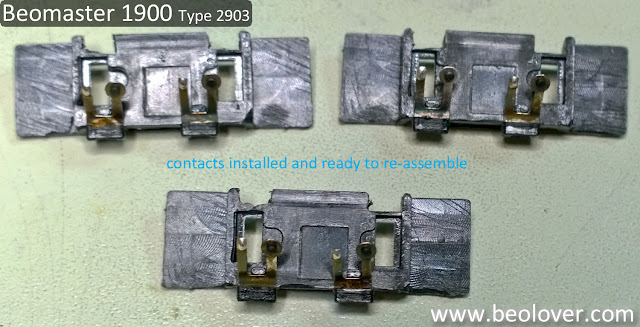I have been running the Beomaster 1900 with borrowed parts from a Beomaster 2400 until the contact bridge replacements for the slide potentiometers arrived from Denmark. Thanks to Martin Olsen they were sent right away and got here really quick.
Making the swap wasn't too bad. The board with the Bass, Treble and Balance slide potentiometers unplugs from the main board so it is easy to desolder the pots.
Here are the slide potentiometers and the replacement parts lined up for assembly.
The three black plastic pieces in the middle are the new contact bridges.
The replacement parts are just the plastic bridges. You must reuse the original contact components.
Here are the ones from this Beomaster installed in the bridges and then assembled into the slide potentiometers.
The bridges are not physically keyed so you could accidentally install them the wrong way. Make sure the bare contacts line up with the metal tracks. It is also important during the handling of the contacts to avoid disturbing the contact with the small, black coal piece.
Once the slide potentiometers are re-assembled their mounting holes to the board are keyed so the only thing to be careful with is that the 50KΩ potentiometer is placed in the Bass mounting location.
The rest of the task is just to snap and solder the potentiometers back into position on the removable board and remount it to the main board.
That is followed by a quick test play to make sure the reworked sliders function properly.
Note that I have the smoked glass display cover removed for polishing.
Featured Post
Beolover SyncDrive: DC Platter Motor Replacement for Beogram 4002 and 4004 (Type 551x and 552x)
Late Beogram 4002 and the 4004 (Types 551x and 552x), which have DC platter motors instead of the earlier synchronous AC motors usually suff...
Subscribe to:
Post Comments (Atom)






No comments:
Post a Comment
Comments and suggestions are welcome!